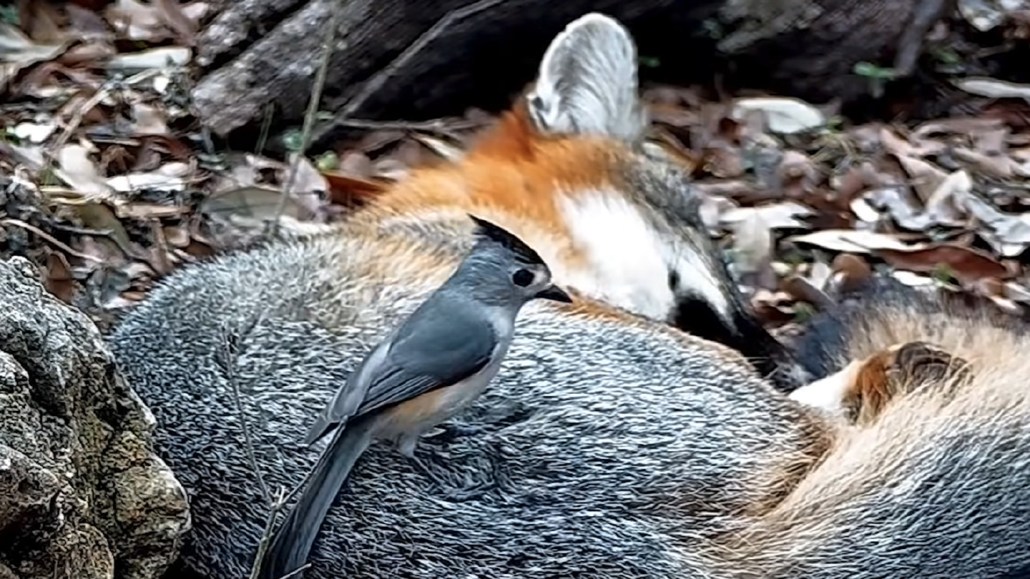There’s a new word for birds stealing animal hair: kleptotrichy
Thieving birds may use their loot to deter predators

This black-crested titmouse (Baeolophus atricristatus) in Texas was caught on video plucking hair from a sleeping fox. Scientists have at last given a name to this bold behavior. It’s kleptotrichy.
Texas Backyard Wildlife
Share this:
- Share via email (Opens in new window) Email
- Click to share on Facebook (Opens in new window) Facebook
- Click to share on X (Opens in new window) X
- Click to share on Pinterest (Opens in new window) Pinterest
- Click to share on Reddit (Opens in new window) Reddit
- Share to Google Classroom (Opens in new window) Google Classroom
- Click to print (Opens in new window) Print
Some tiny birds called titmice take bold risks to gather a beakful of hair for their nests. They dive-bomb cats. They land on dozing predators’ backs. They even pluck strands of hair directly from people’s heads. Now, there’s a term for the unusual behavior: kleptotrichy (Klep-TAH-trik-ee).
The word “kleptotrichy” comes from the Greek words for “to steal” and “hair.” The behavior has rarely been described by scientists. But dozens of YouTube videos catch birds in the act, researchers report July 27 in Ecology. Titmice — and one chickadee — have been recorded on video tugging hair from dogs, cats, humans, raccoons and even a porcupine.
“Citizen scientists, bird watchers and people with dogs knew this behavior much more than the scientists themselves,” says Mark Hauber. He is an animal behaviorist at the University of Illinois at Urbana-Champaign. “Popular observations precede science rather than the other way around, which is a valid way to do science,” Hauber adds.
Witnessing an act of hair thievery in the wild inspired Henry Pollock to dig deeper. Pollock is an ecologist, also at the University of Illinois at Urbana-Champaign. In March 2020, Pollock and his colleagues were counting birds in an Illinois state park. During the count, they saw something unusual: a tufted titmouse plucking fur from a sleeping raccoon. “I was like, ‘Wow, I’ve never seen anything like that,” he says.
Pollock, Hauber and their colleagues wondered if other scientists had seen similar behavior. In South America, birds called palm swifts snatch feathers from flying pigeons and parrots. That behavior is called kleptoptily (klep-TOP-tuh-lee).
But the team found only 11 scientific descriptions of birds stealing hair from live mammals. Most accounts involved titmice in North America. At least five other bird species also get in on the action. Researchers have seen an American crow harvest hair from a cow. A red-winged starling in South Africa has been seen pecking a small antelope called a klipspringer. In Australia, three honeyeater bird species steal fur from koalas.
Meanwhile, a YouTube search by the team turned up 99 videos of birds plucking hair from mammals. Tufted titmice were the most common hair thieves. But a mountain chickadee and a black-crested titmouse were also caught on video stealing mammal hair. Scientists had not previously described those two bird species stealing hair.
Scientists generally assume that birds gather hair for their nests in low-risk ways. For example, they might pull fur from carcasses or collect stray fluff shed into the wind. It was a surprise to learn some birds take bigger risks for hair. “Plucking hairs from raccoons, which are common avian nest predators, suggests that it’s obviously worth [the risk] to get that hair,” Pollock says.
Hair-harvesting bird species tend to live in colder climates. So those birds probably prize hair’s insulating properties for keeping warm, the team says. Some birds might also spruce up their nests with mammal hair to confuse would-be predators and parasites.







